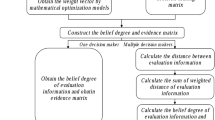Abstract
This paper discusses the fusion of multi-inconsistent decision information systems. First, basic definitions and properties of rough sets, belief and plausibility functions are reviewed. Then, conditional mass function, conditional belief function and conditional plausibility function based on the decision set are defined. We then study the optimal decision of a test set and the reduction of an inconsistent decision information system based on the conditional mass function. Meanwhile, conditional mass function, conditional belief function and conditional plausibility function based on the conditional attribute set are also discussed and we define an uncertainty degree of an inconsistent information system based on the quasi-probability measure. Further, we study fusion method of inconsistent decision information systems using conditional mass functions based on a decision set. Finally, we define a conditional uncertainty measure and give a method to obtain the optimal decision and the confidence level.
Similar content being viewed by others
References
Bienvenu FM, Choquel JB (2004) A new probabilistic and entropy fusion approach for management of information sources. Inf Fusion 5:35–47
Chen DG, Wang CZ, Hu QH (2007) A new approach to attribute reduction of consistent and inconsistent covering decision systems with covering rough sets. Inf Sci 177:3500–3518
Chen DG, Yang WX, Li FC (2008) Measures of general fuzzy rough sets on a probabilistic space. Inf Sci 178:3177–3187
Dempster AP (1967) Upper and lower probabilities induced by a multivalued mapping. Ann Math Stat 38:325–339
Dubois D, Prade H (2005) Interval-valued fuzzy sets, possibility theory and imprecise probability. In: Proceedings of EUSFLAT Conf, pp 314–319
Feng T, Zhang SP, Mi JS (2012) The reduction and fusion of fuzzy covering systems based on the evidence theory. Int J Approx Reason 53:87–103
Fu A, Wang GY, Hu J (2008) Information entropy based attribute reduction algorithm in incomplete information systems. J Chongqing Univ Posts Telecommun (Nat Sci Ed) 20:586–592
Liu GL, Zhu W (2008) The algebraic structures of generalized rough set theory. Inf Sci 178:4105–4113
Pawlak Z (1982) Rough sets. Int J Comput Sci 11:341–356
Pawlak Z (1991) Rough sets: theoretical aspects of reasoning about data. Kluwer Academic Publishers, Boston
Shafer G (1976) A mathematical theory of evidence. Princeton University Press, Princeton
Shannon CE (1949) Communication theory of secrecy systems. Bell Syst Tech J 28:656–715
Skowron A, Stepaniuk J (1996) Tolerance approximation spaces. Fundam Inf 27:245–253
Skowron A, Peters JF (2003) Rough sets: trends and challenges. In: RSFDGrC 2003, LNAI, pp 25–34
Slowinski R, Stefanowski J (1999) Medical information systems-problems with analysis and way of solution. In: Pal SK, Skowron A (eds) Rough fuzzy hybridization: a new trend in decision-making. Springer, Singapore, pp 301–315
Trabelsi S, Elouedi S (2010) Heuristic method for attribute selection from partially uncertain date using rough sets. Int J Gen Syst 39:271–290
Wang CZ, Wu CX, Chen DG (2008) A systematic study on attribute reduction with rough sets based on general binary relations. Inf Sci 178:2237–2261
Wang CZ, Chen DG, Wu C, Hu QH (2011) Data compression with homomorphism in covering information systems. Int J Approx Reason 52:519–525
Wang XZ, Xing HJ, Li Y et al (2014) A study on relationship between generalization abilities and fuzziness of base classifiers in ensemble learning. IEEE Trans Fuzzy Syst. doi:10.1109/TFUZZ.2014.2371479
Wang XZ, Dong LC, Yan JH (2012) Maximum ambiguity based sample selection in fuzzy decision tree induction. IEEE Trans Knowl Data Eng 24(8):1491–1505
Wang XZ, Dong CR (2009) Improving generalization of fuzzy if-then rules by maximizing fuzzy entropy. IEEE Trans Fuzzy Syst 17(3):556–567
Wu WZ, Leung Y, Mi JS (2009) On generalized fuzzy belief functions in infinite spaces. IEEE Trans Fuzzy Syst 17:385–397
Yager RR (1996) On the normalization of fuzzy belief structure. Int J Approx Reason 14:127–153
Yao YY, Lingras PJ (1998) Interpretations of belief functions in the theory of rough sets. Inf Sci 104:81–106
Yao YY (1998) Constructive and algebraic methods of the theory of rough sets. Inf Sci 109:21–47
Zhang WX, Mi JS, Wu WZ (2003) Approaches to knowledge reductions in inconsistent systems. Int J Intell Syst 18:989–1000
Zhong N (2001) Rough sets in knowledge discovery and data mining. Fuzzy Theory Syst 13:581–591
Zhou DM, Duan GY (2010) Research on application of evidence theory in uncertainty reasoning. Appl Res Comput 27:4433–4435
Zhu P (2011) Covering rough sets based on neighborhoods: an approach without using neighborhoods. J Int J Approx Reason 52:461–472
Zhu W (2007) Generalized rough sets based on relations. Inf Sci 177:4997–5011
Acknowledgments
This paper is supported by the National Natural Science Foundation of China (Nos. 61300121, 61170107, 61573127, 61502144), by the Natural Science Foundation of Hebei Province (Nos. A2013208175, A2014205157), Fundation of Hebei Educational Committee (Nos. Q2012093, Z2015143) and by the Doctoral Starting up Foundation of Hebei University of Science and Technology (QD201228).
Author information
Authors and Affiliations
Corresponding author
Rights and permissions
About this article
Cite this article
Zhang, S., Feng, T. Optimal decision of multi-inconsistent information systems based on information fusion. Int. J. Mach. Learn. & Cyber. 7, 563–572 (2016). https://doi.org/10.1007/s13042-015-0441-7
Received:
Accepted:
Published:
Issue Date:
DOI: https://doi.org/10.1007/s13042-015-0441-7




